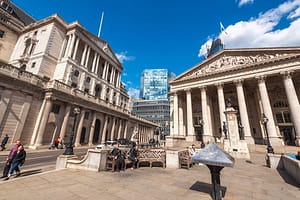Aviva Investors, the global asset management arm of Aviva PLC (‘Aviva’), has revised growth projections marginally higher on the back of more resilient activity data in early 2023, according to the firm’s latest quarterly House View.
However, it has cautioned that risks remain tilted to the downside, especially in some of the major developed economies. While energy prices have fallen back, the conflict in Ukraine still has the capacity to provide negative shocks. Meanwhile, the full impact of monetary tightening has yet to be felt and although peaks in policy rates are close, we may not be quite there yet.
Despite recent events, Aviva Investors does not believe recent banking troubles are comparable to the situation in 2007/8, with banks far better capitalised overall and there being no equivalent credit bubbles. The latest failures in the sector are more likely a reflection of management quality rather than representing a systemic risk to the global financial system. They do, however, show that higher interest rates will expose vulnerabilities and more may yet be revealed.
Elsewhere, Aviva Investors expects mild recessions to remain possible, but these are likely be short-lived given that private sector balance sheets are in good shape, negating the need for an extended remedial period. However, unless underlying inflation starts to return more convincingly towards target, the period of demand restraint may need to be harsher or longer, implying that central banks will need to keep policy in restrictive territory for longer too.
There is an expectation that headline inflation will fall significantly further in coming months, with core inflation to move down also, albeit at a slower pace. Risks are skewed to the upside. Central banks will remain cautious and watchful until or unless this happens more convincingly, but they will also be monitoring financial conditions more generally. These conditions tightened in the wake of banking wobbles, leading to a downward reassessment of policy rate peaks.
Uncertainties implicit in this macro backdrop mean that financial market volatility is likely to remain elevated. Turning points in the cycle are always associated with such uncertainty, but recent experience has been for this to be especially fast-paced and rapidly changing. In these circumstances it is appropriate to adopt a cautious investment approach until there is greater clarity.
Michael Grady, head of investment strategy and chief economist at Aviva Investors, said: “Following a decade or more of near-zero interest rates and quantitative easing, it should not come as a great surprise that some were unprepared for a higher rates environment. Financial sector balance sheets are more robust than in the lead-up to the GFC, with regulators requiring much greater capital and liquidity buffers for banks. Beyond this, some important rules and “plumbing” improvements ought to stabilise “shadow banks” as well.
“However, confidence can quickly evaporate. In a world of digital banking, deposits can run much more easily than in the past. We therefore remain cautious about the near term, with financial stability risks at the forefront of the mind.
“It is because of the rapid recovery from Covid, aided by fiscal stimulus and compounded by the hit to supply, that central banks found themselves having to deal with excess demand and inflation way above target. The objective of raising rates is not to cause financial distress, but rather to temper demand across the economy in the short term and ensure a sustainable long-term growth and inflation outcome.
“We have no misgivings about not having many high-conviction tactical or structural asset class views at present, apart from keeping cash levels high. Equities and credit have repriced through 2022, and rate cuts might eventually be appropriate. But for now, inflation is keeping policymakers hawkish, and some loosening is already priced in, keeping us neutral on government bonds. We are broadly neutral on the dollar, but any growth slowdown would still prove a challenge for EM FX.”






Leave a Comment